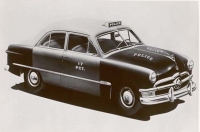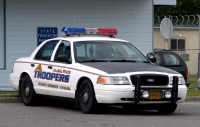 |
A Police Package vehicle is a vehicle built especially for law enforcement use. The two primary types of
Police Package vehicles in North America are:
2) Special Service Vehicles (SSV) / Special Service Package (SSP) Police Package vehicles are generally only available for sale as new vehicles to law enforcement and emergency service agencies. Fire, EMS and other public safety agencies will often use these vehicles. The vehicles come from the manufacturer usually without items such as push bars, radios, light bars, and graphics. It most cases, these items are added later by another company, referred to as an up-fitter. Police markings may be added by a graphics company. A larger police agency may have it's own fleet service department who installs the equipment and graphics. |
| What is the difference between Police Pursuit Vehicle and Special Service Vehicle? | |
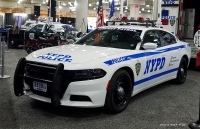 Dodge Charger Pursuit |
Police Pursuit Vehicles (PPV) are what most people think of when someone mentions a police car. These vehicles specifically are rated by the manufacturer for high speed pursuit and/or heavy duty use. Usually a four door sedan, crossover utility, or SUV, these vehicles are equipped with upgraded engine components, heavy duty suspension, breaks, cooling systems, electrical systems, and other special items. Most of the upgrades to these vehicles are to increase durability, not performance. The manufacturer may give a special name to the vehicle such as "Police Interceptor" , "Enforcer" or "Pursuit". |
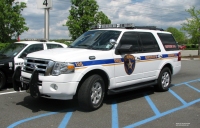 Ford Expedition Special Service Package |
Special Service Vehicle (SSV) also
may be called Special Service Package (SSP) vehicles, are equipped for
non-pursuit support operations or specialized duty. These can be a
pickup truck, crossover utility, SUV, four door sedan, or sports
car. The vehicles are not recommended by the manufacturer for pursuit
or heavy duty use, but have heavier duty and specialized equipment for
police use. These vehicles
are often used as K-9 units, traffic units, supervisor/command units,
off road patrol, and various other support functions. Special Service
vehicles are often similar to fleet only vehicles/packages that
manufacturers offer to organizations who buy large number of vehicles
of similar vehicles. |
|
|
|
| The History of the Police Car and the
Police Package |
|
| From the
early days of the motorized vehicles in the United States , police and
law enforcement agencies that previously used horse drawn
carts/buggies, bicycles, or foot patrols began to use cars,
trucks, and motorcycles, sparingly at first. According to historical
records, the first recorded police car in the United States was in
Akron, Ohio in 1899(1). It was an electric wagon custom
built by the
Collins Buggy Company of Akron, Ohio that featured a stretcher, a cell
for prisoners, seating for 12 people electric headlights, and a warning
gong (1)(2). The Ford Model T was introduced in 1909,
and shortly thereafter began to become popular with police agencies, as
well as the general public. The 1913 to 1927 Ford Model T's were power
by a 20 hp, 177ci, flathead four cylinder engine. By the 1920's police
departments all over the US were on patrol in automobiles. Most of
these cars were 4 cylinder cars. Chevrolet introduced its over-head
valve 6 cylinder engine in 1929, and Ford introduced its famous
flathead V-8 in 1932, winning many fans in police work. Most police
departments bought the best car they could afford. This usually meant a
standard car from the lower priced three automakers: Chevrolet, Ford,
and Plymouth, black in color, with simple "Police" or "PD" markings.
Some police departments used convertible or open top roadsters for
patrol, to increase officer visibility. As vehicles advanced in
technology, electronics began to be used in police vehicles. Emergency
lights, sirens, and radios began to be used on police vehicles.
Automobile manufacturers realized police departments needed vehicles
that were slightly upgraded from what was offered to the general
public. Vehicles that had heavier duty components (wheels, shocks, body
welds, cooling systems, engine mounts, connectors, etc), extra holes
and higher capacity electronic components for wires hooking up
radios, lights, sirens and other equipment, and other assorted vehicle
upgrades. Many of these options and components had been available as
"police items" that were ordered individually. With the 1950 model,
Ford made available the series of commonly ordered, heavy duty, factory
options and components into one ordering package, calling it a "Police
Package"(3) . In 1951 Ford first used the name
"Interceptor" for the optional 110 hp flathead V8 engine in it's Police
Package car.(3) .Chevrolet followed in 1955 with their
Police Package on the all new 1955 Chevrolets with an also new small
block V8. Initially available for 1955 with a long lead time, it was
much more readily available the next model year 1956. General Motors
family member Buick also made police package vehicles starting in
1955, with the Model 68 Century. Buick built 270 of these
two-door sedans especially for the California Highway Patrol, 135 with
manual transmissions and 135 with automatics. The body was from the
lightweight Special, the lowest cost Buick, but the engine was
the 322-cubic inch V8 from the more upscale Century model rated at 236
horsepower, with brakes from the top of the line Roadmaster (6)(7). Dodge offered it's first Police Package on the 1956 Dodge Coronet. (5). Studebaker followed with the 1956 Studebaker Champion, available with a Police Package. (5). For 1956, Dodge had the most success, and the best performance of the 3 Police Package cars available that year. Plymouth, who had a history of making fleet cars for taxi use, entered into the Police Package market in 1957. Pontiac, Oldsmobile, and Mercury were also in the Police Package market, in lesser quantities than the big 4 low cost leaders: Chevrolet, Dodge, Plymouth, and Ford. |
|
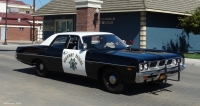 1969 Dodge Polora  1977 Chevrolet Nova 9C1 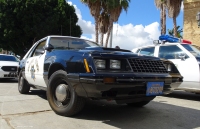 1982 Ford Mustang SSP |
In
the
1960's
even
a
greater variety of models were available, from
mid-sized to full-sized cars. In the mid 1970's, smaller cars were
being used as police cars. The first compact to have wide spread use,
was the 1975-1978 Chevrolet Nova Police Package. 1978 would be the last
year for Buick, Pontiac, and Oldsmobile police cars. General Motors, in
an effort to same money, and keep divisions from competing for the same
market share, GM made Chevrolet the only division to market police
package cars after 1978. The late 70's was also the end of the big
block engined police cars. As the cars and their engines got smaller,
the performance went way down. By 1979 the big engines were gone, and
police departments that wanted a car that could keep up with speeders.
Large cars like the Dodge St Regis, Chevrolet Impala, and Ford LTD
didn't have the power that the cars they replaced. Smaller police cars
like the Chevrolet
Nova,
Chevrolet Malibu,
Dodge
Aspen,
Plymouth
Volare,
and Ford Fairmont became the choice for
some departments looking for something with a bit of performance and
decent gas mileage. Another result of the reduced performance of the
larger police cars, was the introduction of the Special Service Ford
Mustang for police work. In the late 1970's the California Highway
Patrol noticed that the high performance, big-block Dodge police cars
were no longer going to be available after 1978. So they started a
study of alternative vehicles for enforcement duties. The 1979
Chevrolet Camaro Z28 was one of the tested vehicles. While the Camaros that were tested had
mechanical issues, testing
showed that a 2 door sports cars could be used successfully as traffic
enforcement units. It led the way for Ford to introduce the
Mustang Special Service Package in 1982, with the CHP ordering 400 in
1982. Many other highway patrol and police agencies followed the CHP's
lead through the 1980's, using Mustang SSPs for traffic enforcement
and other duties. Chevrolet would not offer a Special Service Package
on it's Camaro until 1991. In the 80's front drive cars were
beginning to be
the norm, and Chevrolet and Chrysler made police special service
packages for some front drive models. Chrysler had the K-car police
models from 1982-1987, and Chevrolet
had the Celebrity police
special service package from 1984-1986. These were made for light duty
police work only. The first "real" police package front drive car was
the 1990 Ford Taurus Police Package. While it had very good
performance and heavy duty components, many departments had problems
with these Fords. It did get police officers ready to accept the front
drive police cars that would come after it, such as the 1995-1999
Chevrolet Lumina and 2000 and after Chevrolet Impala. The Lumina first
was available with a police special service package in 1992. For 1993
Chevy made a both a police special service package and a full Police
Package for the Lumina. The Lumina didn't gain much usage with police
departments until it was redesigned in 1995. After 1996, Ford was the
only automaker that made full sized, rear drive, V-8 police car. The
2000 and later Chevy Impala is seeing much wider use than any front
drive police car has ever had. Ford has had a few lawsuits from
police departments and others about the gas tank on Police Package
Crown Victoria
in the late 90's (10), causing some police departments
to choose the font
drive, V-6 Impala over the rear drive V-8 Ford (11).
The Police Package Crown
Victoria had most
of the market share of the police sales throughout the first decade of
the 2000's, as it became the defacto standard for American police cars. |
 1997-99 Chevrolet Tahoe PPV  2011-16 Chevrolet Caprice PPV 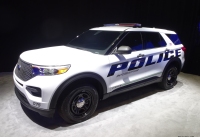 2020 Ford Police Interceptor Utility Hybrid |
The 1980's
and 1990's saw the number different police package cars available
shrink drastically. While back in the 1970's, police departments would
have dozens of police package cars to choose from, by the mid to late
80's the choice was down to the Dodge Diplomat (and identical Plymouth
Gran Fury) , Chevrolet Caprice, and Ford LTD Crown Victoria. 1989 was
the last year for the Dodge and Plymouth police cars, leaving just Ford
and Chevy. The Ford Taurus Police Package did come out in 1990 and
Chevrolet Lumina Police Package in 1993, but most departments were not
ready for a front drive, V-6 police car yet. Chevrolet stopped making
the rear drive Caprice in 1996, leaving only Ford with a rear drive
car. Chevy did come out with a new rear drive, V-8 Police Package in
1997, with the Tahoe Police Package. But that was a truck, and not what
most police departments were looking for at the time. The Chevrolet
Tahoe
Police Package was made from 1997-1999, a was a true police car with
all the heavy duty and performance components. It was only available in
2wd, and was an inch lower, had a different grill, and was much faster
than a regular Tahoe. While many Police Package Tahoes did see use,
most departments went with Ford Crown Victorias for patrol cars. For
2000 Chevrolet replaced the Lumina with the all new Impala.
DaimlerChrysler introduced a police package for its front drive Dodge
Intrepid for 2002. Police officers now seem ready for front
drive police cars, now that the performance of cars like the police
Impala and Intrepid closely match that of the full sized, rear drive
Ford. In 2004 Dodge stopped making the Intrepid, leaving just the Ford
Crowns Victoria, Chevrolet Impala, and Chevrolet Tahoe as the only
choices for police departments. For 2006 Dodge returned to the police
car market, with exactly what police departments were asking for,
rear-drive cars. The Dodge Magnum station wagon and Dodge Charger sedan
were made available with police packages. Both cars are rear drive,
with either a high performance HEMI V-8 or a good performing, good fuel
economy V-6. The Charger and Magnum were the most advanced police cars
at the time, with the latest high performance HEMI V-8 from Chrysler,
stability control, ABS, and modern but aggressive styling. Ford
continued to make the Crown Victoria, with no major body changes from
1998 to 2011. In 2005 Chevrolet brought back the 2 wheel drive police
package for the Tahoe, calling it the Tahoe Police Pursuit Vehicle or
Tahoe PPV for short. Chevrolet had made a special service package of
the 4 wheel drive Tahoe since 2001. General Motors introduced a new
vehicle to the American police car market for the 2011 model year with
the Chevrolet Caprice 9C1 PPV. Based on the Australian made Holden
Caprice, this full
sized, rear drive, V-8 or V-6 sedan was built by GM's Australian
division Holden. GM did not offer a civilian version of the Caprice in
North America, but did offer the related, but shorter wheelbase
Chevrolet SS to retail consumers. The Caprice PPV was in production
from model years 2011 to 2017. The
Ford Crown Victoria continued to be the most used vehicle by
police departments up until its end of production for the 2011 model
year. Ford introduced two new vehicles for the police car market in
2012, as early 2013 models. The Ford Police Interceptor Sedan, based on
the Ford Taurus, and the Ford Police Interceptor Utility, based on the
Ford Explorer. The new modern Ford police vehicles ride on the same
platform, and shared many components. Both Fords were available with
front or all wheel drive and V-6 engines. These continued in production
into the 2019 model year. As the Ford Taurus was discontinued, the
Police Interceptor Sedan it was based on was also discontinued. The
replacement is the Ford Police Responder Hybrid Sedan, based on the
Ford Fusion Hybrid. It is the first pursuit rated hybrid police car.(8).
Ford
introduced
a
new
Ford Explorer, and associated Police Interceptor
Utility for model year 2020, on a new platform, with all wheel drive
and hybrid powerplant, the first-ever pursuit-rated hybrid police
SUV (9). In the early 2000's, a company
called Carbon Motors began development of what they called the world's
first purpose built police car (12). It was to be a car
built from the ground up for police use, and not based on any existing
production vehicle. While there was initial interest from police
agencies and investors, as well as a deal with BMW for purchase of
six-cylinder diesel engines for use in the vehicles, the company never
made any production vehicles, only a prototype revealed in 2008.
Carbon Motors shut down in 2013 (13). |
back
(1)
http://ci.akron.oh.us/News_Releases/2009/0225.htm
(2) https://www.thevintagenews.com/2017/12/04/first-police-car/
(3) https://www.ford.com/police-vehicles/
(4)Sanow, Edwin J. "Chevrolet Police Cars." Krause Publications. 1997.
(5) Sanow, Edwin J. Encyclopeida of American Police Cars, MBI Publishing, 1999
(6) https://www.fopconnect.com/article/recovery-from-the-storm/10-greatest-cop-cars/
(7) https://autoweek.com/article/car-news/1955-buick-century-broderick-crawford-special-and-lawman-growled-10-4
(8) https://www.ford.com/police-vehicles/hybrid-police-responder/
(9) https://www.ford.com/police-vehicles/hybrid-utility/
(10) https://www.upi.com/Top_News/2002/09/27/Ford-to-shield-police-cruiser-fuel-tanks/18011033155351/
(11) https://www.the-dispatch.com/news/20040514/lexington-police-department-to-put-impalas-on-patrol
(12) https://carbonmotors.com/
(13) https://jalopnik.com/is-carbon-motors-dead-465692494
(2) https://www.thevintagenews.com/2017/12/04/first-police-car/
(3) https://www.ford.com/police-vehicles/
(4)Sanow, Edwin J. "Chevrolet Police Cars." Krause Publications. 1997.
(5) Sanow, Edwin J. Encyclopeida of American Police Cars, MBI Publishing, 1999
(6) https://www.fopconnect.com/article/recovery-from-the-storm/10-greatest-cop-cars/
(7) https://autoweek.com/article/car-news/1955-buick-century-broderick-crawford-special-and-lawman-growled-10-4
(8) https://www.ford.com/police-vehicles/hybrid-police-responder/
(9) https://www.ford.com/police-vehicles/hybrid-utility/
(10) https://www.upi.com/Top_News/2002/09/27/Ford-to-shield-police-cruiser-fuel-tanks/18011033155351/
(11) https://www.the-dispatch.com/news/20040514/lexington-police-department-to-put-impalas-on-patrol
(12) https://carbonmotors.com/
(13) https://jalopnik.com/is-carbon-motors-dead-465692494


